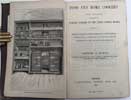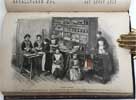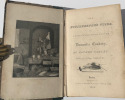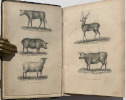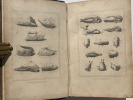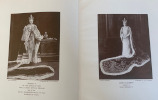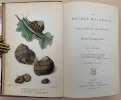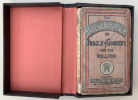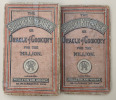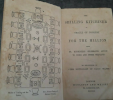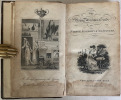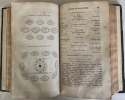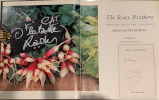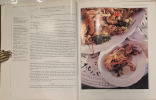THE MODERN HOUSEHOLDER:
A MANUAL OF DOMESTIC ECONOMY IN ALL ITS BRANCHES. COMPILED AND EDITED BY A MEMBER OF THE ROYAL COLLEGE OF SURGEONS. With original Illustrations Printed in Colours by Tronheim. AND NUMEROUS WOODCUTS. (A round printer’s device for Warne and Co.) LONDON: FREDERICK WARNE AND CO. BEDFORD STREET, COVENT GARDEN. NEW YORK: SCRIBNER, WELFORD, AND ARMSTRONG.
FIRST AND SOLE EDITION - 1st ISSUE. Thick 8vo. 194 x 135 mm. 1fep. [1] Frontispiece of Potatoes. 1 tissue-guard. Title page. [1] (1)vi Preface. (1)viii Contents. (1)x List of Coloured Plates. (1)x List of Woodcuts. (1)2-689. (1)691-722 Index. 2p Advertisements. 1fep. 19 Coloured plates. Many In-text woodcut Illustrations. Very clean internally. Modern ¼ leather binding with marbled boards. Flat spine with gilt lines and text. In very good condition.
- Interestingly, there are 2 exact same copies of this book except for the frontispieces. They are different in both copies. One has as a frontis of the colour plate that faces page 54, featuring various flower ornamentations. This copy has the frontispiece, illustrating the various types of potatoes. This was published first, and one suspects, that because the publishers did not issue a large print run, and due to higher demand, they inserted the other forntis for the second issue. The book format is similar to Beeton’s great household management book, especially with the fine colour plates and in-text b/w woodcut illustrations. In many ways it also as interesting as Beeton’s but quite different in content. An example is Ross Murray’s recipes on pages 338/9 for roasting and making gravy from Swan. As can be seen online, there are many articles on the cooking of Swans, with some of the information edited and reproduced here: Due to the law since the 12th century, all swans at liberty on open waters belong to the Crown by prerogative right, and are the property of the Crown. Mute swans (the common Eurasian swan we see in UK, having the familiar white plumage and an orange-red bill with a black knob at the base) also have statutory protection under the Wildlife and Countryside Act. By 1378 the office of 'Keeper of the King's Swans' was in existence and a document exists, entitled, "The Lawes, Orders and Customs for Swans", dating to 1482/3. From a gastronomic viewpoint, mature swans have little subcutaneous fat and their flesh is exceedingly dry, making them a tough and entirely unsuitable subject for barbecuing. This is what Ross Murray writes; “The cygnets when all hatched are of a slate-grey, which grows lighter as they grow older. The cygnets of the wild swan are white. But it is of the grey cygnets we have to speak. They are hatched in June. If they are intended for the kitchen, they are put into a separate swan pond at the end of August or the first week in September. After they have been "hopped or upped", as it is called, from their native place, grass is thrown to them twice a day with their other food for a fortnight. They are fattened on barley: a coomb (4 bushels) for each cygnet suffices for the fattening. Cygnets can only be fattened before the white feathers appear; after that no further feeding will do any good. As soon as a white feather shows they will cease fattening, no matter what food they have. They can consequently only be eaten in December, and they are a capital and magnificent Christmas dish. Their weight then will be from 25 lbs to 28 lbs.” They were slaughtered the moment their white adult plumage appeared, which pretty well coincided with Christmas. They were seven months old and very obese. Murray goes on to tell us that swan was a popular local dish in Norfolk and explains how they were roasted in homes in that county on a spit in front of the fire as a Christmas dish. He explains that the finished swan was garnished with four little swans carved out of turnips and 'a paper frill, nicely cut, about the shoulders. Other famous Chefs have recipes for swan in their cookery books. Published by the 17th century master cook Robert May, in his famous tome entitled; ‘The Accomplisht Cook’, (item # 10965 on this site) he gives recipes for 'A Swan roast' and 'A Swan Pye'. Nearly a hundred years after May published the bill of fare above, another Christmas dinner featuring a swan pie, this time as a centrepiece for the first course appeared in John Thacker's The Art of Cookery (Newcastle upon Tyne: 1758). Thacker was the cook to the Dean and Chapter at Durham Cathedral where there had been a swannery since well before the Reformation. Edward Kidder also published in his beautiful cookery book (see item # 10966 on this site), a small recipe for Swan Pye on page 6.






click on image to enlarge

Antiquarian category
ref number:
11243 




